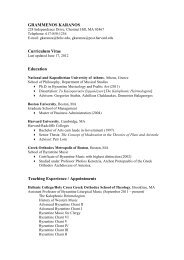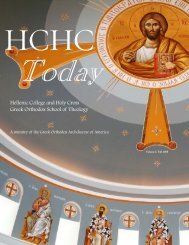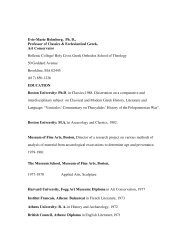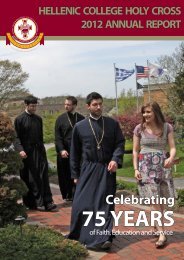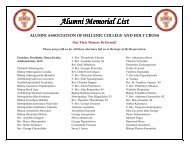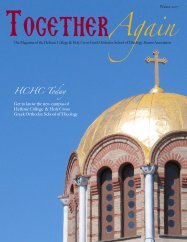Celebrating Sacred Art - Hellenic College
Celebrating Sacred Art - Hellenic College
Celebrating Sacred Art - Hellenic College
Create successful ePaper yourself
Turn your PDF publications into a flip-book with our unique Google optimized e-Paper software.
“Time and nature are made new”: worldly space is transfigured; perspective,<br />
which puts man in the position of an outside observer, no<br />
longer exists. The believer, the pilgrim, is a guest at the Wedding. He<br />
is inside, and sees the whole world from the inside. History is interpreted<br />
differently: the events of divine Economy are not past and closed<br />
but present and active. They embrace us, they save us. What we have<br />
in the icon is not a neutral, faithful historical representation but a dynamic<br />
liturgical transformation. In iconography the events of salvation<br />
are not interpreted historically but expressed mystically and embodied<br />
liturgically; they interpenetrate with one another. They become a witness<br />
to the “different way of life” which has broken through the bounds<br />
set by corruption. They invite us to a spiritual banquet, here, now.<br />
The faithful do not know the Lord and His saints through recollection<br />
or by looking back into history. They have the Divine Liturgy, the holy<br />
icon. Being baptized into the joy of the new creation, they enter into<br />
the iconographic and liturgical world where they find the Lord and the<br />
saints alive.<br />
They come<br />
into immediate<br />
contact and communion with life. They sing<br />
the triumphal hymn with the blessed spirits. They<br />
offer worship for forefathers, fathers, patriarchs,<br />
prophets…(the unity of the faith and the communion<br />
of the Holy Spirit. It is not the creation or improvisation<br />
of some genius. It does not serve merely<br />
artistic ends. It does not divide up history. For the<br />
world of the icon, distance in space and the passing<br />
of time do not exist. What the icons expresses<br />
is not the fragmentation characteristic of the present<br />
age, but the unifying power of the Liturgy.<br />
The ethos of the Orthodox saint and the expression<br />
of Orthodox hagiography are akin: both combine<br />
humility and magnificence. In both life wells up behind<br />
an outward appearance of motionlessness, and<br />
there is a “hidden beauty.” Nothing laughs frivolously<br />
and wounds the sorrowful. Nothing shows an<br />
inconsolable misery that brings death. Victory is a<br />
certainty, and everything is expressed with the calm<br />
and joy of contrite devotion that tames what is wild<br />
and brings to life what is mortal.<br />
Archimandrite Vasileios, Hymn of Entry (New York: SVS Press,<br />
1998) pp. 82-84.<br />
Beauty is an objective principle in the world, revealing to us the divine glory… . <strong>Art</strong> brings about the transfiguration<br />
of the world and renders it conformable to its true image… . Things are transfigured and made luminous<br />
by beauty; they become the revelation of their own abstract meaning.<br />
S. Bulgakov, in E.L. Mascall, ed., The Church of God (London: SPCK, 1934) pp. 176-177.<br />
Together Again December 2012 23



